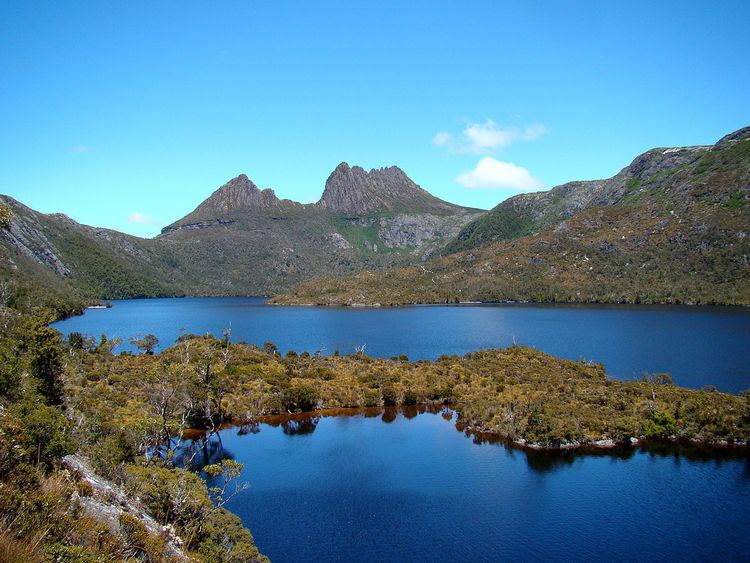Area 1,614 km² Established 1922 | Visitation 209,000 (in 2005) Phone +61 3 6289 1172 | |
 | ||
Managing authorities Management | ||
Cradle mountain lake st clair national park tasmania
Cradle Mountain-Lake St Clair National Park is located in the Central Highlands area of Tasmania (Australia), 165 km northwest of Hobart. The park contains many walking trails, and is where hikes along the well-known Overland Track usually begin. Major features are Cradle Mountain and Barn Bluff in the northern end, Mount Pelion East, Mount Pelion West, Mount Oakleigh and Mount Ossa in the middle and Lake St Clair in the southern end of the park. The park is part of the Tasmanian Wilderness World Heritage Area.
Contents
- Cradle mountain lake st clair national park tasmania
- Access
- Usage fee
- Development
- Biodiversity
- Birds
- Fungi
- In film
- References
Access
Access from the south (Lake St. Clair) is usually from Derwent Bridge on the Lyell Highway. Northern access (Cradle Valley) is usually via Sheffield, Wilmot or Mole Creek. A less frequently used entrance is via the Arm River Track, from the east.
Usage fee
In 2005, the Tasmanian Parks and Wildlife Service introduced a booking system and fee for use of the Overland Track over peak periods. Initially the fee was $100, but this was raised to $150 in 2007, and as at August 2011 is $180. The money that is collected is used to finance the park ranger organisation, track maintenance, building of new facilities and rental of helicopter transport to remove waste from the toilets at the huts in the park.
Development
The Tasmanian Government has moved to allow development in national parks and conservations areas. An 'In principle' permit has been granted for the establishment of an 'eco-friendly' resort at Pumphouse Point at Lake St Clair.
Biodiversity
The Cradle Mountain-Lake St Clair National Park is a significant location of Tasmania's endemic species — 40–55% of the park's documented alpine flora is endemic. Furthermore, 68% of the higher rainforest species recorded in alpine areas in Tasmania are present in the Cradle Mountain-Lake St Clair National Park. The park's alpine vegetation is very diverse and has largely escaped forest fires that have caused neighbouring regions to suffer.
Animals present in the park include: pademelons, Bennett's wallabies, quolls, Tasmanian devils, echidnas, platypuses, wombats, possums, ravens and currawongs.
Birds
The park has been identified as an Important Bird Area (IBA) because it provides habitat for 11 of Tasmania's endemic bird species, as well as for the flame and pink robins and the striated fieldwren. The IBA is important as a representative protected area in north-central Tasmania for those species.
Fungi
Fungi are also a part of the Park's biodiversity. While the Management Plan for Cradle Mountain–Lake St Clair National Park only mentions fungi in the context of their destructive effects (Phytophthora cinnamomi and Chalara australis), the Park has a great variety of fungi that perform beneficial ecological roles. In fact, most fungi perform positive rather than negative roles. Even parasitic fungi – often regarded only negatively – are a vital part of healthy ecosystems, regulating ecosystem functions.
As primary recyclers of organic matter, saprobic fungi break down fallen branches and leaf litter, making vital nutrients available to other organisms. Other fungi form symbiotic relationships with other organisms. Although rarely acknowledged, the great majority of plants in Cradle Mountain–Lake St Clair National Park (indeed in the world) form mutually beneficial mycorrhizal relationships with fungi.
Given the great diversity of plants, specialist habitats and micro-climates in the park, a great diversity of fungi, including lichens, is also expected to occur there. Several hundred species have already been recorded by field naturalists and interested individuals and can be found in the Atlas of Living Australia.
Despite their essential roles in underpinning terrestrial ecosystems, fungi are barely recognised as a vital part of Australia's biodiversity. Although Australia has national and state level biodiversity conservation strategies and has ratified international conventions, most overlook fungi, including Tasmania's Natural Heritage Strategy, which only makes one generic reference to fungi.
One of the more a conspicuous species found in the wetter parts of the park is the strawberry bracket fungus (Aurantiporus pulcherrimus). It is a Gondwanan species (also found in New Zealand and southern Brazil) that grows on myrtle beech (Nothofagus cunninghammii) and snow gums. The Australian citizen-science organisation, Fungimap is documenting and mapping the distribution of fungi including those that occur in National Parks. Cortinarius metallicus is a mycorrhizal species also found in the park.
In film
This area was used to film the first two segments of the Discovery Channel documentary When Dinosaurs Roamed America. Those two segments were set in Late Triassic New York and Early Jurassic Pennsylvania.
